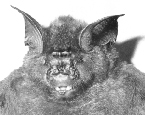|
Great
Leaf-nosed Bat
(Hipposideros armiger) |
||||
|
|
Physical
characteristics and distribution
|
|
The
genus Hipposideros has body lengths ranging from 35-110
mm, tail lengths from 18-70 mm, and forearm lengths of about
33-105 mm. Adult H. armiger weights are between 40-60
grams. Color ranges from reddish to a shade of brown on the
upperparts and paler underparts. There
are two breeding periods for H. armiger, pregnant females
have been recorded in February - May and September - October.
|
|
Description
of the brain
|
|
Animal
source and preparation
|
|
All
specimens collected followed the same preparation
and histological procedure.
|
Other
Related Resources (websites and publications)
List of Specimens | Explore Collections | Brain Sections | Brain Evolution | Brain Development | Brain Circuitry | Brain Functions | Location and Use | Related Web Sites | Contact Us | Search MSU Database | Personnel | Home



